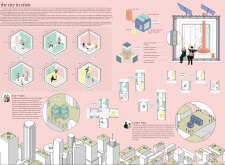5 key facts about this project
The project features modular dwelling units designed for quick assembly and scalability, emphasizing the ability to respond effectively to population displacement. Each unit is approximately 25 square meters, providing essential amenities such as kitchenettes, bathrooms, and communal areas. These units can be interconnected, allowing for versatile configurations that cater to different community needs.
Adaptability and Emergency Response
One of the defining characteristics of "The City in Crisis" is its emergency adaptability. The design allows for rapid deployment in crisis situations, offering immediate shelter or quarantine options. This feature positions the project as a vital solution for urban environments facing sudden displacements, whether due to economic factors or natural disasters. The modular design also promotes efficient use of resources, minimizing material waste while responding to urgent housing demands.
Sustainability and Community Integration
Sustainability is a primary focus within the project, illustrated through its careful selection of materials and energy-efficient technologies. Recycled metal panels serve as external cladding, promoting energy efficiency and reducing the environmental impact. Insulation made from mushroom mycelium provides ecological benefits while ensuring adequate thermal performance. Other sustainable materials include recycled plywood for interior finishes and sustainably sourced timber for structural support.
The integration of green roofs and community gardens speaks to the project’s commitment to not only enhancing urban biodiversity but also fostering a sense of community. Shared amenities such as communal kitchens and workshop spaces are designed to encourage collaboration among residents, supporting social interaction, skill sharing, and community engagement.
The unique design approach of "The City in Crisis" lies in its dual focus on immediate functionality and long-term sustainability. By situating the project within urban contexts where housing crises are prevalent, it reflects a deep understanding of contemporary living conditions. The design invites exploration of innovative solutions that can be adapted to various urban settings.
For more technical insights into "The City in Crisis," including architectural plans, sections, and detailed designs, readers are encouraged to delve into the project presentation. Understanding the architectural ideas and design strategies can provide a deeper appreciation of this timely intervention in urban housing.























